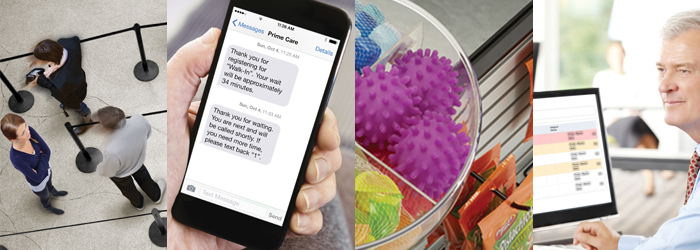Everyone can appreciate a smooth car ride, a plane ride without turbulence, and a smooth wait in line without any speed bumps like inefficiency or dodgy practices. In an ideal world there would be no waiting in line, but that’s just not realistic.
Still, marking time doesn’t have to create dissatisfaction among customers; you can take action to make a queue shorter and faster, and help the people waiting in those lines calm their restless energy. Here’s how to make it happen:
1. Occupy their time.
You don’t have to have children of your own to know that unoccupied time is a dangerous animal. Occupied time feeds the mind, keeps the hands busy, and distracts you from the wait at hand – though we may grow up, these truths never change, and waiting in a queue can nearly drive us to throw a tantrum.
So find something for your customers to do. Keep them busy with digital signage in the queue that plays interesting or entertaining videos or informational advertisements. Pepper your queue with in-line merchandising that presents unique or useful products your customers can explore (and purchase). You might even consider a virtual queuing solution, allowing customers to relax or shop some more as they wait to be called to service – anything but making them stand around with nothing to do but wait.
2. Get them started.
The waiting is over once the transaction or service begins. People just want to get started and the sooner you can make this happen, the better. A classic example of this is the grocery store where, once you begin unloading your cart you feel that your wait is over and you’re officially being served. A bank and other service centers can give people the opportunity to complete paperwork while standing in line.
A fast food restaurant can send representatives into the queue to begin taking customer orders. Retailers can send associates into the line to relieve patrons of armloads of clothing and begin the process of folding and prepping for the register. The point is, getting your customers started before they reach your service point increases both the efficiency of your line and the satisfaction of your patrons.
3. Reduce the anxiety.
The savvy businessperson knows that you don’t just set up barriers for a queue and leave it to its own devices. An unmanaged queue can grow teeth very quickly, so manage your waiting lines and reduce the anxiety of the people in them by carefully planning their purpose. Single-line queuing promotes fairness and reduces the need for people to jockey for the “best” line or the “right” line – it’s first come, first served, so there is no sense of injustice among customers.
Electronic queuing reduces anxiety by announcing through visual or auditory cues that another agent is available to provide service – there’s no need for customers to pay close attention to what’s happening in other lines because the digital signage will do the work for them. Virtual queuing allows people to relax while they wait, no jostling in line or feeling crowded – and where there is relaxation, there is less anxiety!
4. Make the wait time known.
Uncertainty also causes anxiety. And when a customer doesn’t know how long their wait in line is going to be, they become antsy, irritated, and impatient. That’s because uncertain waits are longer than known, finite waits.
So provide your waiting customers with information – it’s the key to breaking that feeling of angst that uncertainty breeds. Use signage or other electronic cues to inform people about how long their wait time will be and you’ll discover that they’ll be more patient about waiting. They’ll love you even more if their wait time ends up being shorter than anticipated.
5. Promote fairness.
Unfair waits in line feel longer to people than equitable waits, so do everything you can to keep each queue designed in a fair and balanced manner. Probably the single best way to promote fairness is to have just one line. Single-line queuing features “first come, first served” as its modus operandi, making it unquestionably fair.
Consider other ways to promote fairness by establishing a clear cut system for queue jumping (cutting ahead in line). If it’s allowed, as in cases where VIP customers get priority service, make it clear and equitable by giving these customers a separate line. If it’s not allowed, mark your line clearly with stanchions and barriers that make the boundaries clear.
Ready to develop a smooth customer flow for your queue?
Create a more enjoyable checkout experience for your customers and revel in better results for your business or organization. Consult the public guidance experts at Lavi for recommendations customized to fit your space and needs.










